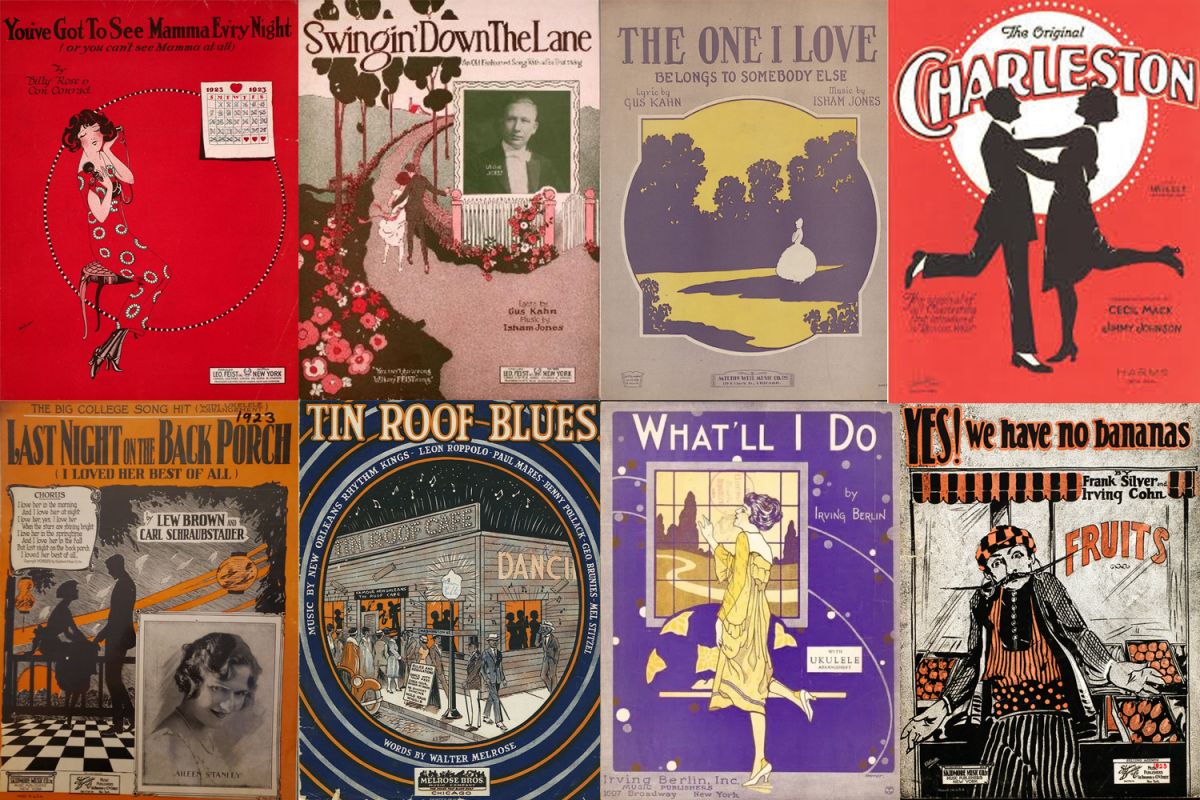MUSIC CLIP - OSCAR PETERSON, “MOONGLOW”
Welcome to Afterglow, [a show of vocal jazz and popular song from the Great American Songbook], I’m your host, Mark Chilla.
This week, I’m once again continuing our 1920s retrospective, with a spotlight on the songs of the year 1923. A century ago, the music world was much different: radio still wasn’t widespread, recordings were just beginning to catch on with the public, and icons like Louis Armstrong and Bessie Smith were just starting to cut their first records. But many of the songs from this year, from writers like Isham Jones and Irving Berlin, have had a life that extended many decades into the future. This hour, we’ll hear some more modern versions of these songs like “What’ll I Do,” “I Cried For You,” and “Tin Roof Blues.”
It’s The Songs of 1923, coming up next on Afterglow
MUSIC - FRANK SINATRA, “THE ONE I LOVE BELONGS TO SOMEBODY ELSE” (1940)
Frank Sinatra, the Pied Pipers, and Tommy Dorsey and his Orchestra in 1940 performing the Isham Jones and Gus Kahn tune “The One I Love Belongs To Somebody Else.” That song was first recorded by the Isham Jones Orchestra in December 1923, although didn’t become a hit until the following year, when Al Jolson recorded the vocals in 1924.
This recording became a hit for Sinatra 16 years later, hitting number 11 on the charts, and became associated with Sinatra over the course of his career. He recorded it several more times in fact. In 1961, he recorded it for the album I Remember Tommy, a tribute album to his former boss, who had passed away a few years earlier. Sy Oliver, who also worked with Dorsey, did the arrangement here.
MUSIC CLIP - FRANK SINATRA, "THE ONE I LOVE BELONGS TO SOMEBODY ELSE" (1961)
He also recorded it two years earlier in 1959, in a much more somber arrangement by Gordon Jenkins.
MUSIC CLIP - FRANK SINATRA, "THE ONE I LOVE BELONGS TO SOMEBODY ELSE" (1959)
MUSIC CLIP - PAUL WHITEMAN AND HIS ORCHESTRA, "CHARLESTON"
Mark Chilla here on Afterglow. On this show, we’re turning back the clock to hear the songs that have endured from the year 1923.
1923 was a pivotal time in American music history. New Orleans pianist Jelly Roll Morton and King Oliver's Creole Jazz Band, featuring a young trumpeter named Louis Armstrong, were making their first recordings, laying down the foundation for jazz. Bessie Smith was making her first recordings, laying down the foundation for blues. And Fiddlin' John Carson was making his first recordings, laying down the foundation of what would soon be called “country music.”
One of the big hits from the year was the song you’re hearing in the background right now, stride pianist James P. Johnson’s “ Charleston.” The song first made an appearance in the 1923 all-black musical Runnin’ Wild, and by the end of the decade “Charleston” and its associated dance craze had essentially defined the Roaring Twenties.
It’s mostly known today as an instrumental tune, but it does have lyrics, first sung by Elisabeth Welch in the show Runnin’ Wild. Let’s hear another vocal version from over two decades later. This is Louis Prima and his Orchestra with “Charleston,” on Afterglow.
MUSIC - LOUIS PRIMA, “CHARLESTON”
MUSIC - LOUIS PRIMA, “YES! WE HAVE NO BANANAS”
Two of the biggest hit songs from 1923. Just now, the Frank Silver Irving Cohn novelty tune “Yes! We Have No Bananas,” first sung by vaudeville star Eddie Cantor and sung here in 1949 by Louis Prima. Before that, Prima again in 1950 with the dance crazy of 1923, “Charleston.”
Two of the most enduring jazz standards from the 1923 are “Who’s Sorry, Now?,” by Burt Kalmar, Harry Ruby, and Ted Snyder, and “I Cried For You,” by Arthur Freed, Gus Arnheim, and Abe Lyman. Each of these songs has been performed hundreds of times over the century, by artists like Billie Holiday, Sarah Vaughan, Nat King Cole, and Ray Charles. And most interestingly to me, both songs are about the exact same topic: a person who once got their heart broken, delighting in the fact that the person who broke their heart is now suffering themself.
Let’s hear both of these songs. We’ll start with Ella Fitzgerald with pianist Paul Smith in 1960. This is the Burt Kalmar, Harry Ruby, and Ted Snyder song “Who’s Sorry Now?” on Afterglow.
MUSIC - ELLA FITZGERALD, “WHO’S SORRY NOW?”
MUSIC - CARMEN MCRAE, "I CRIED FOR YOU (NOW IT'S YOUR TURN TO CRY OVER ME)"
Two jazz standards from the year 1923, both about getting emotional revenge on someone who broke your heart. Just now, we heard Carmen McRae in 1962 with “I Cried For You,” and before that Ella Fitzgerald in 1960 with “Who’s Sorry Now?”
Broadway provided several of the big hit songs of 1923. Some well-known Broadway names were still beginning to emerge. Oscar Hammerstein scored his first smash this year with the show Wildflower, co-written with Otto Harbach and Vincent Youmans, although the popularity of the songs from that show didn’t extend beyond the 1920s. Irving Berlin was in the midst of writing an annual revue show for his Music Box Theatre, a venue that he owned at the time (and still exists to this day on Broadway, in fact!). During the run of his Music Box Revue of 1923, Berlin added a love song to the show, which later became a hit and then eventually an enduring standard.
We’ll hear that now. This is Nat King Cole and the King Cole Trio in 1947 with Irving Berlin’s “What’ll I Do?” on Afterglow.
MUSIC - NAT KING COLE, “WHAT’LL I DO”
MUSIC - BILLY ECKSTINE, “I LOVE YOU”
Two Broadway hits from 1923. Just now, we heard Billy Eckstine from his 1960 album Once More With Feeling, performing the Harlan Thompson and Harry Archer song “I Love You,” the hit song from the biggest hit show of 1923 called Little Jessie James. The arrangement here was by Billy May, and it bears a striking resemblance to the arrangement he made of this same song for Frank Sinatra several years earlier. Note: this “I Love You,” should not be confused with the later Cole Porter song “I Love You,” which Sinatra also recorded. Before that, we heard Nat King Cole in 1947 with Irving Berlin’s “What’ll I Do,” a love song Berlin added to the Broadway show Music Box Revue of 1923, but a song that wasn’t officially published until 1924.
MUSIC CLIP - JELLY ROLL MORTON, "KING PORTER STOMP"
Another hit song from 1923 in the background right now, Jelly Roll Morton’s “King Porter Stomp.” We’ll have more of the songs from 1923 in just a moment, stay with us.
I’m Mark Chilla, and you’re listening to Afterglow
MUSIC CLIP - BENNY GOODMAN AND HIS ORCHESTRA, "KING PORTER STOMP"
MUSIC CLIP - BESSIE SMITH, "AGGRAVATIN' PAPA"
Welcome back to Afterglow, I’m Mark Chilla. We’ve been exploring the songs of 1923 this hour, turning back the clock 100 years. And what you’re hearing in the background right now is a song that was recorded in 1923 by the great blues singer Bessie Smith.
Radio still wasn’t widespread in 1923, but recorded music was really starting to catch on. Smith cut her very first records this year, and that fact alone makes 1923 a landmark year in American music history. Although Smith’s recorded output was small, her influence on later generations of jazz, blues, and even rock singers was vast. Let’s hear one of those early Bessie Smith songs, written by songwriter Clarence Williams in 1923.
This recording is from several years later in 1940. Here is Ella Fitzgerald and Her Famous Orchestra with “Gulf Coast Blues,” on Afterglow.
MUSIC - ELLA FITZGERALD AND HER FAMOUS ORCHESTRA, "GULF COAST BLUES"
MUSIC - DAMITA JO, "NOBODY KNOWS YOU WHEN YOU'RE DOWN AND OUT"
Jazz and pop singer Damita Jo in 1965 with the 1923 song “Nobody Knows You When You’re Down And Out.” That song was introduced by its composer Jimmy Cox on the vaudeville stage in 1923, although it became famous in 1929 when it was recorded by blues singer Bessie Smith. It’s since been recorded by jazz, blues, and R&B singers like Nina Simone, Sam Cooke, Louis Jordan and more. Before that, another 1923 song made famous by Bessie Smith. That was “Gulf Coast Blues,” written by Clarence Williams, and performed there by Ella Fitzgerald and Her Famous Orchestra in 1940.
Many of the songs from 1923 have lived on because of their association with Bessie Smith. That’s the power of stardom. Many great songs have been forgotten to history because they were never attached to a star. But Bessie Smith was not the only star from 1923. Another was vaudeville comedienne and singer Sophie Tucker, the so-called “Last Of The Red Hot Mamas.” Tucker, a Russian immigrant, was one of the most popular entertainers of the early 20th century, known for her commanding stage presence and her comic delivery of often riqué songs.
Here’s one of Sophie Tucker’s most well-known songs, written in 1923 by songwriters Con Conrad and Billy Rose. This is Peggy Lee in 1958 with “You’ve Got To See Mamma Ev’ry Night (Or You Can’t See Mamma At All),” on Afterglow.
MUSIC - PEGGY LEE, "YOU’VE GOT TO SEE MAMMA EV’RY NIGHT"
MUSIC - SAMARA JOY, "LINGER AWHILE"
The 2023 Grammy Award winner for Best New Artist Samara Joy, performing a song from 100 years earlier, 1923. That was the Vincent Rose and Harry Owens song “Linger Awhile.” That song was a hit for Paul Whiteman’s Orchestra in the 1920s, but was also turned into a fast-paced swinger by Sarah Vaughan in 1953, likely the inspiration for Joy. That comes from Joy’s album also titled Linger Awhile, an album that also won the Grammy Award for Best Jazz Vocal album. Before that, we heard Peggy Lee in 1958 with the song “You’ve Got To See Mamma Ev’ry Night,” written by Con Conrad and Billy Rose (no relation to Vincent Rose).
One of the most famous bandleaders from 1923 with Isham Jones. Jones was a saxophonist It was around this time when he first started to achieve fame, and that fame continued well into the early 1930s. Jones was also a songwriter and a successful one at that. Between 1922 and 1925, for instance, Isham Jones had written eight songs that topped the pop charts. Here’s one that he wrote and recorded in 1923, a song that not only topped the chart for six weeks in 1923, but was also the second most popular song from that calendar year.
Here’s a recording more than 30 years later. This is Frank Sinatra in 1956 with the 1923 Isham Jones and Gus Kahn tune “Swingin’ Down The Lane,” on Afterglow.
MUSIC - FRANK SINATRA, "SWINGIN' DOWN THE LANE"
MUSIC - BING CROSBY, "LAST NIGHT ON THE BACK PORCH"
Bing Crosby in 1957 from his album Bing With A Beat, performing the 1923 song “Last Night On The Back Porch,” a song written by Carl Schraubstader and Lew Brown for the stage show George White’s Scandals of 1923. Before that, we heard Frank Sinatra in 1956 from his album Songs For Swingin’ Lovers, with one of the top songs from 1923, Isham Jones and Gus Kahn’s “Swingin’ Down The Lane.”
I have one more song from 1923 that I want to feature this hour, and it’s one of the more interesting songs from this year: the quintessential New Orleans jazz standard “Tin Roof Blues.” The song was first recorded on March 13, 1923 at Gennett Records in Richmond, Indiana by the New Orleans Rhythm Kings, an influential all-white jazz group, and the song was credited to five of the group’s members. Although some historians have noted the similarities between the melody of “Tin Roof Blues” and the earlier song “Jazzin’ Babies Blues,” written by the Black jazz pianist Richard M. Jones.
It wasn’t a hit in 1923. The New Orleans Rhythm Kings were not a pop act. But in the years since, “Tin Roof Blues” has stood the test of time. According to the website Secondhand Songs, “Tin Roof Blues” has been covered more times than any other song from that calendar year. The melody was even the basis of the song “Make Love To Me,” a number one pop single for singer Jo Stafford in 1954.
Here’s a version from another New Orleans jazz king Louis Armstrong in 1966. This is Louis Armstrong with the classic 1923 standard “Tin Roof Blues,” on Afterglow
MUSIC - LOUIS ARMSTRONG, "TIN ROOF BLUES"
Louis Armstrong in 1966 with the 1923 traditional jazz standard “Tin Roof Blues.”
In the background right now, a 1923 recording of Louis Armstrong. This is his song he co-wrote called “Tears,” performed here with King Oliver’s Jazz Band.
Thanks for tuning in to this “Song Of 1923” edition of Afterglow.
MUSIC CLIP - KING OLIVER'S CREOLE JAZZ BAND, "TEARS"
Afterglow is part of the educational mission of Indiana University and produced by WFIU Public Radio in beautiful Bloomington, Indiana. The executive producer is John Bailey.
Playlists for this and other Afterglow programs are available on our website. That’s at indianapublicmedia.org/afterglow.
I’m Mark Chilla, and join me next week for our mix of Vocal Jazz and popular song from the Great American Songbook, here on Afterglow










